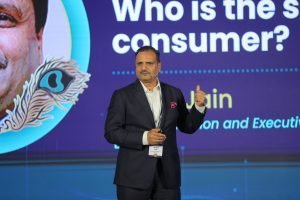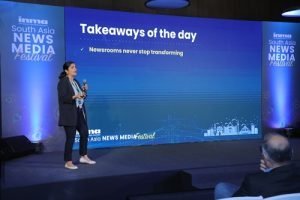
Although artificial intelligence ruled the INMA meet in Delhi in July, other important topics for debate and discussion were disruptions in the traditional news media economy, how to recalibrate the print business model, capacity building, effective monetization of digital, and the need to find alternative sources of revenue.
Bharat Gupta’s insights on India’s changing media landscape set the ball rolling for the two-day South Asia News Media Conference. Gupta – CEO of Jagran New Media, and a prominent face in media confabs – spoke about ad revenue and technology in India’s now channel-agnostic media and entertainment sector as well the spike of digital creator economy on account of the deep internet penetration across the length and breadth of the country. Of the 821 million active internet users (55% penetration) in India, rural accounts for 442 million, he said.
Gupta, president of INMA’s South Asia Division, detailed three great disruptions in Indian news media – the rise of the creator economy, direct-to-consumer brands, and AI & ML. The creator economy consists of individual channels and influencers on digital platforms such as YouTube and Instagram.

Citing data, Gupta said influencer marketing will grow at an 18% CAGR and India’s influencer marketing industry may reach Rs 34 billion (US$ 4.2 billion) by 2026. “We expect a majority of large brands to use influencers by 2026,” he said, in what could be a warning bell for news media houses that depend on brands for ad revenue.
In the same breath, he sounded a note of caution about the fear of unverified news. “Over 1 billion websites globally produce voluminous content, leading to a potential rise in misinformation and disinformation and leaving the consumer gasping for trusted or reliable sources,” he pointed out, indicating the flip side of the content boom and perhaps, the opportunity for authenticity and fact-based news.
Gupta then touched on how AI is slowly making its way into newsroom workflow, the rise of D2C brands, and how news publishers are getting a short-shrift in the Rs 50,000-crore big data lake that includes the likes of Amazon, Google, and Meta. His presentation ended with his success mantra – ‘solve, ideate, innovate, collaborate, build, buy and partner.’
In a subsequent session, Mohit Jain, COO, publication, and executive director, BCCL, explained how despite all the focus on GenZ, it is GenX that is the biggest wealth creator and spender. Independent and more empowered than before, GenX is ahead of GenZ in spending on travel, real estate, and online shopping – therein lies an opportunity for marketers.
Biprorshee Das, editor, WARC India discussed with Pawan Agarwal, deputy managing director, Dainik Bhaskar Group; Puneet Avasthi, senior executive director, Kantar; Aditi Mishra, CEO, Lodestar-UM; and Dhruba Mukherjee, CEO, ABP Group, how the print business model is re-shaping itself amid evolving news consumption patterns. They stressed the resilience of print and how it is giving space to digital to build an ecosystem where both mediums complement each other.
Greg Pichoata, Readers First Initiative lead, INMA, United Kingdom, in an unusual reference to Old Delhi’s spice traders came up with interesting insights that the news media can emulate from them – remix goods, bundle services, and differentiate; analyze the market, choose a segment, focus; know your customers, their needs, innovate; and, invest or collaborate to concentrate demand. “Sell journalism to people and not news, as news is a commodity but journalism isn’t,” was Pichoata’s suggestion to avoid commoditization. Avoid the commodity trap by redefining the value proposition, becoming readers first, and investing in distribution, he said.
Sabrina Daryanani, head of APAC and principal of FT Strategies, Singapore, offered several preparatory steps that news publishers can take immediately to prepare for the audiences of 2030. These include building affinity with audiences by way elevating existing journalists, encouraging authenticity, and partnering with creators; modernizing language by being simple but not simplistic, and experimenting with alternative tones. Her suggestions included enhancing personalization and customization; catering to different modes of consumption; and developing socially friendly content to build direct relationships.
In another panel, Ritu Kapur of Quint Digital, Bharat Gupta, Suparna Singh, co-founder and CEO of Frammer AI; Praveen Someshwar, CEO & MD of HT Media; and Tushar Vyas, chief strategy officer, WPP, discussed the challenges and opportunities of present and future revenue-driven models. Basant Rathore of Jagran Prakashan, Sridhar Aranala of The Hindu Group, and Ashok Sharma of Amar Ujala spoke about strengthening the print distribution network, bridging the last-mile gap, exploring the subscription model and a relook at the revenue model for vendors.

Yusuf Omar, co-founder of Seen TV, Australia, unpacked how to produce, monetize and distribute video while Spotify’s Amarjit Singh Batra shared how the Swedish digital music service managed to build a strong base in India in just five years. In what can be seen as a diversification model, Udit Jain, vice-president of digital strategy and growth, at Outlook, shared the company’s roadmap to building a content-to-commerce business.
A big takeaway from the conference, as aptly summed by Shelly Walia, executive editor of The Quint, is that cross-media or hybrid existence is the future. With the media landscape becoming format-agnostic, marketers, agencies, and news publishers need to rethink their media planning strategies. “As consumers flit seamlessly from print to TV to digital, what can they do for a brand when there’s a whole spectrum of media choices?” she asked. The big differentiator is to build integrated media planning (or cross-media combos) and content tailored for each of those media choices. The future for agencies and news publishers is increased collaboration, convergence as well as diversification, Walia concluded.
















